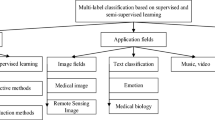Abstract
In multi-instance learning, the training set comprises labeled bags that are composed of unlabeled instances, and the task is to predict the labels of unseen bags. In this paper, a web mining problem, i.e. web index recommendation, is investigated from a multi-instance view. In detail, each web index page is regarded as a bag, while each of its linked pages is regarded as an instance. A user favoring an index page means that he or she is interested in at least one page linked by the index. Based on the browsing history of the user, recommendation could be provided for unseen index pages. An algorithm named Fretcit-kNN, which employs the Minimal Hausdorff distance between frequent term sets and utilizes both the references and citers of an unseen bag in determining its label, is proposed to solve the problem. Experiments show that in average the recommendation accuracy of Fretcit-kNN is 81.0% with 71.7% recall and 70.9% precision, which is significantly better than the best algorithm that does not consider the specific characteristics of multi-instance learning, whose performance is 76.3% accuracy with 63.4% recall and 66.1% precision.
Similar content being viewed by others
References
O. Maron, “Learning from ambiguity,” PhD dissertation, Department of Electrical Engineering and Computer Science, MIT, Jun. 1998.
T.G. Dietterich, R.H. Lathrop, and T. Lozano-Pérez, “Solving the multiple-instance problem with axis-parallel rectangles,” Artificial Intelligence, vol. 89, nos. 1–2, pp. 31–71, 1997.
P.M. Long and L. Tan, “PAC learning axis-aligned rectangles with respect to product distributions from multiple-instance examples,” Machine Learning, vol. 30, no. 1, pp. 7–21, 1998.
P. Auer, P.M. Long, and A. Srinivasan, “Approximating hyper-rectangles: Learning and pseudo-random sets,” Journal of Computer and System Sciences, vol. 57, no. 3, pp. 376–388, 1998.
P. Auer, “On learning from multi-instance examples: Empirical evaluation of a theoretical approach,” in Proceedings of the 14th International Conference on Machine Learning, Nashville, TN, 1997, pp. 21–29.
A. Blum and A. Kalai, “A note on learning from multiple-instance examples,” Machine Learning, vol. 30, no. 1, pp. 23–29, 1998.
O. Maron and T. Lozano-Pérez, “A framework for multiple-instance learning,” in Advances in Neural Information Processing Systems 10, edited by M.I. Jordan, M.J. Kearns, and S.A. Solla, MIT Press: Cambridge, MA, 1998, pp. 570–576.
O. Maron and A.L. Ratan, “Multiple-instance learning for natural scene classification,” in Proceedings of the 15th International Conference on Machine Learning, Madison, WI, 1998, pp. 341–349.
C. Yang and T. Lozano-Pérez, “Image database retrieval with multiple-instance learning techniques,” in Proceedings of the 16th International Conference on Data Engineering, San Diego, CA, 2000, pp. 233–243.
J. Wang and J.-D. Zucker, “Solving the multiple-instance problem: A lazy learning approach,” in Proceedings of the 17th International Conference on Machine Learning, San Francisco, CA, 2000, pp. 1119–1125.
G. Ruffo, “Learning single and multiple instance decision tree for computer security applications,” PhD dissertation, Department of Computer Science, University of Turin, Torino, Italy, Feb. 2000.
Y. Chevaleyre and J.-D. Zucker, “Solving multiple-instance and multiple-part learning problems with decision trees and decision rules. Application to the mutagenesis problem,” in Lecture Notes in Artificial Intelligence 2056, edited by E. Stroulia and S. Matwin, Springer: Berlin, 2001, pp. 204–214.
Z.-H. Zhou and M.-L. Zhang, “Neural networks for multi-instance learning,” Technical Report, AI Lab, Computer Science & Technology Department, Nanjing University, Nanjing, China, Aug. 2002.
Q. Zhang and S.A. Goldman, “EM-DD: An improved multi-instance learning technique,” in Advances in Neural Information Processing Systems 14, edited by T.G. Dietterich, S. Becker, and Z. Ghahramani, MIT Press: Cambridge, MA, 2002, pp. 1073–1080.
Q. Zhang, W. Yu, S.A. Goldman, and J.E. Fritts, “Content-based image retrieval using multiple-instance learning,” in Proceedings of the 19th International Conference on Machine Learning, Sydney, Australia, 2002, pp. 682–689.
Z.-H. Zhou and M.-L. Zhang, “Ensembles of multi-instance learners,” in Lecture Notes in Artificial Intelligence 2837, edited by N. Lavrac, D. Gamberger, H. Blockeel, and L. Todorovski, Springer: Berlin, 2003, pp. 492–502.
S. Ray and D. Page, “Multiple instance regression,” in Proceedings of the 18th International Conference on Machine Learning, Williamstown, MA, 2001, pp. 425–432.
R.A. Amar, D.R. Dooly, S.A. Goldman, and Q. Zhang, “Multiple-instance learning of real-valued data,” in Proceedings of the 18th International Conference on Machine Learning, Williamstown, MA, 2001, pp. 3–10.
L. De Raedt, “Attribute-value learning versus inductive logic programming: The missing links,” in Lecture Notes in Artificial Intelligence 1446, edited by D. Page, Berlin: Springer, 1998, pp. 1–8.
J.-D. Zucker and J.-G. Ganascia, “Changes of representation for efficient learning in structural domains,” in Proceedings of the 13th International Conference on Machine Learning, Bary, Italy, 1996, pp. 543–551.
J.-D. Zucker and J.-G. Ganascia, “Learning structurally indeterminate clauses,” in Lecture Notes in Artificial Intelligence 1446, edited by D. Page, Springer: Berlin, 1998, pp. 235–244.
B.V. Dasarathy, Nearest Neighbor Norms: NN Pattern Classification Techniques, Los Alamitos, CA: IEEE Computer Society Press, 1991.
D.W. Aha, “Lazy learning: Special issue editorial,” Artificial Intelligence Review, vol. 11, nos. 1–5, pp. 7–10, 1997.
T.G. Dietterich, A. Jain, R.H. Lathrop, and T. Lozano-Pérez, “A comparison of dynamic reposing and tangent distance for drug activity prediction,” in Advances in Neural Information Processing Systems 6, edited by J. Cowan, G. Tesauro, and J. Alspector, San Mateo: Morgan Kaufmann, 1994, pp. 216–223.
G.A. Edgar, Measure, Topology, and Fractal Geometry, Springer: Berlin, 1990.
T. Joachims, “A probabilistic analysis of the Rocchio algorithm with TFIDF for text categorization,” in Proceedings of the 14th International Conference on Machine Learning, Nashville, TN, 1997, pp. 143–151.
Author information
Authors and Affiliations
Corresponding author
Rights and permissions
About this article
Cite this article
Zhou, ZH., Jiang, K. & Li, M. Multi-Instance Learning Based Web Mining. Appl Intell 22, 135–147 (2005). https://doi.org/10.1007/s10489-005-5602-z
Issue Date:
DOI: https://doi.org/10.1007/s10489-005-5602-z




